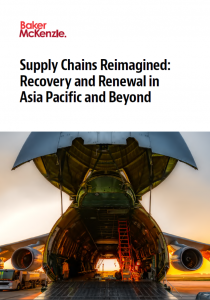
As businesses and economies reopen and demand increases, attention is now shifting toward seeking recovery of global supply chains in Asia Pacific. Currently, demand remains below 2019 levels — and is expected to remain so for an extended period. Hence, whether companies are looking to enter or move supply chain operations around or away from the Asia Pacific region, they are increasingly motivated to secure lower-cost suppliers and focus their efforts on maintaining their financial health in the short to medium-term.
For businesses seeking to renew their supply chain operations, these shifts will be both significant and, in many cases, long-term. Global companies who are reliant on Asia Pacific supply chain networks will need to consider the rewards and risks of shifting or diversifying operations within, beyond or into the region. Key considerations need to be factored in, such as whether product categories are exposed to new tariffs or specific protectionist policies and how to respond to mitigate these risks and get ahead of worsening trade barriers. Additionally, digitalization and sustainability considerations are core to supply chain evolution, intertwined with considerations around diversification
and restructuring.
The hot debate in this renewal phase will be whether companies, global or Asia Pacific based, reshore manufacturing or relocate to jurisdictions seen as better able to service key markets. Commentary on trade wars has included considerable rhetoric and speculation about companies deciding whether to diversify supply chain operations. However, exiting an existing key market is not a decision lightly taken, nor a simple decision to action, particularly for a company with a globally integrated supply chain. There can be many factors to weigh up. For example, insights from research interviews show that there is strong sentiment to continue investing in China, in part because of its large and growing market.
Download report here: Supply Chains Reimagined_17 Aug

